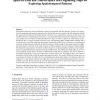Free Online Productivity Tools
i2Speak
i2Symbol
i2OCR
iTex2Img
iWeb2Print
iWeb2Shot
i2Type
iPdf2Split
iPdf2Merge
i2Bopomofo
i2Arabic
i2Style
i2Image
i2PDF
iLatex2Rtf
Sci2ools
CGF
2010
2010
Space-in-Time and Time-in-Space Self-Organizing Maps for Exploring Spatiotemporal Patterns
Spatiotemporal data pose serious challenges to analysts in geographic and other domains. Owing to the complexity of the geospatial and temporal components, this kind of data cannot be analyzed by fully automatic methods but require the involvement of the human analyst's expertise. For a comprehensive analysis, the data need to be considered from two complementary perspectives: (1) as spatial distributions (situations) changing over time and (2) as profiles of local temporal variation distributed over space. In order to support the visual analysis of spatiotemporal data, we suggest a framework based on the "Self-Organizing Map" (SOM) method combined with a set of interactive visual tools supporting both analytic perspectives. SOM can be considered as a combination of clustering and dimensionality reduction. In the first perspective, SOM is applied to the spatial situations at different time moments or intervals. In the other perspective, SOM is applied to the local tempo...
| Added | 09 Dec 2010 |
| Updated | 09 Dec 2010 |
| Type | Journal |
| Year | 2010 |
| Where | CGF |
| Authors | Gennady L. Andrienko, Natalia V. Andrienko, Sebastian Bremm, Tobias Schreck, Tatiana Von Landesberger, Peter Bak, Daniel A. Keim |
Comments (0)

